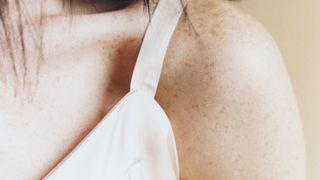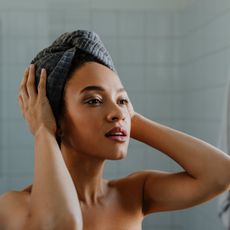
From the droves of natural specks we collected during the summer as kids, to the faux ones we draw on because the runways inspire us to, freckles are always a fascinating subject to broach. Here, find a slew of things you probably didn't know about the sun-induced specks.
1. There are two different kinds of freckles. The more common of the two are ephelides, which are flat, light brown marks that tend to fluctuate with the seasons. "They can get darker in summer and lighter in the winter time," explains Rachel Nazarian, a board-certified dermatologist at Schweiger Dermatology. "In fact, people can see them fade even after applying sunscreen for several weeks."
Then there are lentigines, AKA liver or age spots, where the the skin contains even more melanocycte cells and thus, doesn't typically change based on exposure to sunlight.
2. They're genetic. Freckles are linked to a key genetic player in regulating your skin and hair color. A gene known as MC1R controls how much of two different kinds of melanin you produce. The two types are 1) darker brown eumelanin and 2) reddish-yellow pheomelanin. If your MC1R gene is inactive, you'll produce more pheomelanin leading to light hair/skin, as well as a propensity for freckles.

3. Nobody is born with them. Have you ever seen a newborn baby with freckles? Nope. Never. "Despite what some people say, freckles are absolutely always from sun exposure," says Nazarian. "They cause the pigment making cells in your skin to rev up and create more pigment."
4. They're an indication of how sensitive your skin is to the sun. In some people, melanin is produced evenly through the skin. When it's not, freckles are little clumps of melanin that fluctuate with the sun. If you've got a lot of specks, your skin is more sensitive and you're at great risk for skin cancer. (Though freckles are never cancerous themselves.)
5. They double as natural sunscreen. The melanocytes act as a natural sunscreen by darkening your face and thus make the skin less susceptible to UV rays. But seriously, it's no excuse not to be applying and reapplying a minimum of SPF 30 daily.
Stay In The Know
Marie Claire email subscribers get intel on fashion and beauty trends, hot-off-the-press celebrity news, and more. Sign up here.
"They are still a risk factor for skin cancer because they're caused by ultraviolet light, so if you make a lot of freckles, you should be very vigilant about your skin health and get your annual skin check," cautions Nazarian.

6. Not all redheads have them. While redheads have less melanin in their skin, contrary to popular belief, not all of them have freckles. They're thought to be controlled by the same gene, but red hair is recessive, and freckles are a dominant trait. Roughly 80% of redheads have an MC1R gene.
7. In Medieval times, they were considered witches' marks. Never mind the fact that men have and will alway be just as susceptible them–right up there with moles, warts, and birth marks—freckles were said to be indicative of a women's allegiance to the devil.
Follow Marie Claire on Facebook for the latest celeb news, beauty tips, fascinating reads, livestream video, and more.

Lauren is the former beauty editor at Marie Claire. She love to while away the hours at coffee shops, hunt for vintage clothes, and bask in the rough-and-tumble beauty of NYC. She firmly believes that solitude can be a luxury if you’ve got the right soundtrack—that being the Rolling Stones, of course.
-
 Katie Holmes Does Outfit Repeating for Spring (Somewhat)
Katie Holmes Does Outfit Repeating for Spring (Somewhat)If the actress can re-shop her favorite pieces, then so can everyone.
By India Roby Published
-
 Taylor Swift Says 'The Tortured Poets Department' Is the End of Her “Fleeting and Fatalistic” Era
Taylor Swift Says 'The Tortured Poets Department' Is the End of Her “Fleeting and Fatalistic” Era"This period of the author’s life is now over, the chapter closed and boarded up," she says.
By Quinci LeGardye Published
-
 Who Helped Taylor Swift Write ‘The Tortured Poets Department’? One Co-Writer Speaks Out After Album Release
Who Helped Taylor Swift Write ‘The Tortured Poets Department’? One Co-Writer Speaks Out After Album Release"We started working on these songs over two years ago and it feels like they have kept us company..."
By Danielle Campoamor Published
-
 The 32 Best Hair Growth Shampoos of 2024, According to Experts
The 32 Best Hair Growth Shampoos of 2024, According to ExpertsRapunzel hair, coming right up.
By Gabrielle Ulubay Published
-
 The 20 Best Hair Masks for Damaged Hair, According to Experts and Editors
The 20 Best Hair Masks for Damaged Hair, According to Experts and EditorsHealthy strands, here we come!
By Gabrielle Ulubay Last updated
-
 How Often You Should Wash Your Hair, According To Experts
How Often You Should Wash Your Hair, According To ExpertsKeep it fresh, my friends.
By Gabrielle Ulubay Published
-
 The 11 Best Magnetic Lashes of 2023
The 11 Best Magnetic Lashes of 2023Go ahead and kiss your messy lash glue goodbye.
By Hana Hong Published
-
 Beauty Advent Calendars Make the Perfect Holiday Gift
Beauty Advent Calendars Make the Perfect Holiday GiftThe gift that keeps on giving.
By Julia Marzovilla Last updated
-
 The 18 Best Natural Hair Products in 2023
The 18 Best Natural Hair Products in 2023Remember: Your curls are your crown.
By Gabrielle Ulubay Published
-
 The 9 Best Hot Rollers for the Curls of Your Dreams
The 9 Best Hot Rollers for the Curls of Your DreamsThis is how we roll.
By Samantha Holender Published
-
 The 12 Best Cream Eyeshadows, According to Makeup Artists
The 12 Best Cream Eyeshadows, According to Makeup ArtistsThe best part? They’re so easy to apply.
By Samantha Holender Published